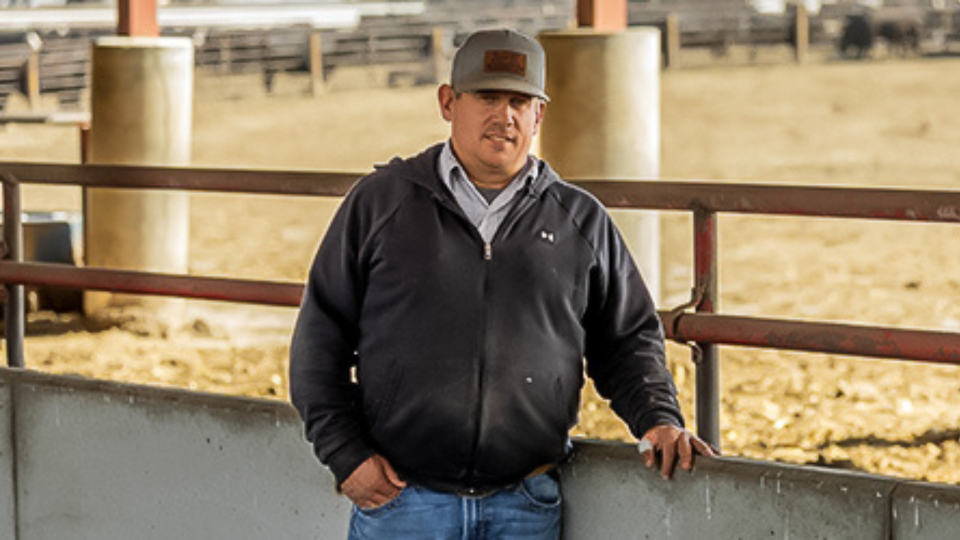Midwest producers share perspectives
on BRD management
Ninety miles separate the Upper Midwest cattle operations of Wes Christensen of Royal, Iowa, and Don Christensen of Beresford, South Dakota. The Christensens are not related, but they do share a common challenge, managing bovine respiratory disease (BRD).
They’re not alone. BRD has been the No. 1 cause of disease and death in cattle feedlots of North America.1 Both morbidity and death loss can have significant impacts on feedlot profitability.
In Royal, Iowa, Wes Christensen handles around 7,000 head of steers per day at three different locations. Commingling cattle from different regions, he says, leads to BRD being the main herd health issue they face in their operation.

To combat BRD, the protocol used in his operation is to treat the full pen if they’ve treated 10%-15% of the animals in the first couple of weeks. After consultation with their veterinarian, Wes opted for a product with longer duration of effectiveness against BRD.
“We choose ZUPREVO® (tildipirosin) because it’s long-lasting and provides immediate results,” he says. “We use it for 90% of cases with early respiratory illness signs — it’s our go-to for first pulls and first treats, and we rarely have to treat again.”
“ZUPREVO stays in cattle longer and we see a lower death loss in those that we treat, so we know it’s effective,” states Wes. “We also like the convenience of giving one small dose that’s easy to administer.”
Across the border into South Dakota, Don Christensen addresses similar herd health issues also caused by cattle coming in from multiple locations. “We’re a family of farmer feeders with a few cow-calf pairs and farm to feed cattle,” he says. “Most of our cattle come from the sale barn.”
“When receiving cattle, the biggest thing we can do is start them well and get them eating to help them get past health challenges in those first couple of weeks.”
Like many other producers, Don sees more BRD cases in the damp, cooler conditions during fall. After a friend recommended ZUPREVO, he tested it out on a pen.
“The cattle treated with ZUPREVO stayed steady and kept climbing, whereas others at about two weeks were breaking down and getting sick,” he states.
“We see ZUPREVO working within 24 hours.2 Animals feel better and start eating, and we don’t need to treat those animals again,” Don adds. “It works. It’s long-lasting and keeps cattle animal healthy longer — we don’t have any re-pulls with ZUPREVO.”
Cattle operations deploying ZUPREVO in their herd health programs find it’s easy to work with, goes to work quickly and is long-lasting. It is:
- Easy to dose. Administer 1mL/100 pounds of body weight.
- Highly syringable and offers a 21-day preslaughter withdrawal period.
- Designed to go to work quickly, reaching peak plasma concentrations in just 45 minutes. It transports and distributes well throughout lung tissues.3
- Outlasts the competition. It has prolonged concentration for 28 days in lung tissue — the site of action — and 21 days in bronchial fluids.3,4
ZUPREVO is labeled for common BRD bacteria:
- For treatment of BRD associated with Mannheimia haemolytica, Pasteurella multocida and Histophilus somni in beef and non-lactating dairy cattle.
- For the control of respiratory disease in beef and non-lactating dairy cattle at high risk of developing BRD associated with M. haemolytica, P. multocida and H. somni.
Every animal counts. It’s never been more important to maximize productivity. Jumping on BRD with an effective health protocol helps the Christensens blunt the impact of respiratory diseases and allow cattle on feed at their Midwestern operations to thrive.
It is important to work with your veterinarian to diagnose the disease, determine treatment protocols and advance your outcomes of BRD.
Important Safety Information
ZUPREVO: FOR USE IN ANIMALS ONLY. NOT FOR HUMAN USE. KEEP OUT OF REACH OF CHILDREN. TO AVOID ACCIDENTAL INJECTION, DO NOT USE IN AUTOMATICALLY POWERED SYRINGES WHICH HAVE NO ADDITIONAL PROTECTION SYSTEM. IN CASE OF HUMAN INJECTION, SEEK MEDICAL ADVICE IMMEDIATELY AND SHOW THE PACKAGE INSERT OR LABEL TO THE PHYSICIAN.
Cattle intended for human consumption must not be slaughtered within 21 days of the last treatment. Do not use in female dairy cattle 20 months of age or older. Use of this drug product in these cattle may cause milk residues. A withdrawal period has not been established in pre-ruminating calves. Do not use in calves to be processed for veal.
The effects of ZUPREVO® 18% on bovine reproductive performance, pregnancy and lactation have not been determined. Swelling and inflammation, which may be severe, may be seen at the injection site after administration. Subcutaneous injection may result in local tissue reactions which persist beyond slaughter withdrawal period. This may result in trim loss of edible tissue at slaughter.
DO NOT USE ZUPREVO® 18% IN SWINE. Fatal adverse events have been reported following the use of tildipirosin in swine. NOT FOR USE IN CHICKENS OR TURKEYS.
References
- Griffin D. Economic impact associated with respiratory disease in beef cattle. Vet. Clin. North Am. Food Anim. Pract. 1997;13:367–377.
- Clinical effectiveness of Zuprevo has been evaluated and approved by the FDA at day 14 post treatment per Prescribing Information.
- The correlation between pharmacokinetic data and clinical effectiveness is unknown.
- Menge M., et al. Pharmacokinetics of tildipirosin in bovine plasma, lung tissue, and bronchial fluid (from live, non-anesthetized cattle). J. Vet. Pharm. Ther. 2011;1349:1365-2885.
Find more content for your beef operation.
